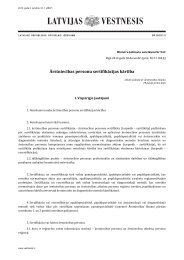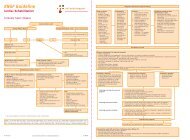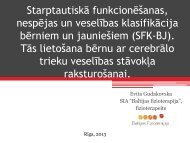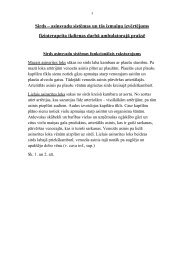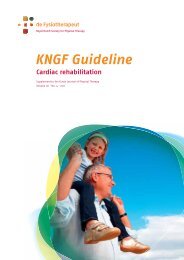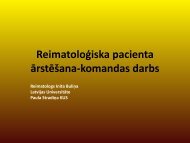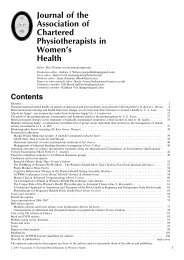Create successful ePaper yourself
Turn your PDF publications into a flip-book with our unique Google optimized e-Paper software.
<strong>Low</strong> <strong>Back</strong> <strong>Pain</strong>: Clinical Practice Guidelines<br />
and the 36-month follow-up, the stabilization group outperformed<br />
the walking group, with 55% of the stabilization<br />
group and only 26% of the walking group meeting the predetermined<br />
criteria for success. This research demonstrates<br />
that a graded exercise intervention emphasizing stabilizing<br />
exercises seems to improve perceived disability and health<br />
parameters at short and long terms in patients with recurrent<br />
low back pain.<br />
Choi and colleagues53 performed a review of ran-<br />
I domized controlled trials that examined the effectiveness<br />
of exercise in the prevention of low back<br />
pain recurrence. This was published in a Cochrane review.<br />
Treatments were defined as exercise including strengthening,<br />
endurance, and aerobic activity that occurred during the<br />
patient’s episode of care with a healthcare practitioner as well<br />
as those that occurred following discharge from a healthcare<br />
practitioner. Specific types of exercise were not assessed individually.<br />
The group found 9 studies that met their criteria<br />
for inclusion. There was moderate-quality evidence that the<br />
number of recurrences was significantly reduced in 2 studies<br />
(mean difference, –0.35; 95% CI: –0.60, –0.10) at 0.5 to 2<br />
years' follow-up. There was very low-quality evidence that the<br />
days on sick leave were reduced in patients who continued to<br />
perform low back exercises following discharge (mean difference,<br />
–4.37; 95% CI: –7.74, –0.99) at 0.5 to 2 years’ followup.<br />
In summary, there was moderate-quality evidence that<br />
postdischarge exercise programs can prevent recurrences of<br />
low back pain.<br />
In a randomized controlled trial, Hides et al156 com-<br />
I pared a 4-week specific exercise training program<br />
to advice and medication in a group of patients with<br />
first-episode low back pain. The specific exercise group performed<br />
cocontraction exercises believed to facilitate training<br />
of the lumbar multifidus and transversus abdominis muscle<br />
groups. The specific exercise group reported recurrence rates<br />
of 30% at 1 year and 35% at 3 years, compared to 84% at 1<br />
year and 75% at 3 years for the advice and medication control<br />
group.<br />
O’Sullivan et al234 completed a randomized con-<br />
I trolled trial involving subjects with radiologically<br />
confirmed spondylolysis or spondylolisthesis. A<br />
specific exercise group received weekly interventions directed<br />
at training to promote isolation and cocontraction of<br />
the deep abdominal muscles and the lumbar multifidus. A<br />
control group received usual care typically consisting of aerobic<br />
exercise, rectus abdominis training, and modalities. At<br />
the conclusion of the 10-week program, the specific exercise<br />
group demonstrated statistically significant improvements<br />
in both pain intensity and functional disability. These gains<br />
were maintained at a 30-month follow-up.<br />
a34 | april 2012 | volume 42 | number 4 | journal of orthopaedic & sports physical therapy<br />
Yilmaz and colleagues326 investigated the efficacy of<br />
I a dynamic lumbar stabilization exercise program<br />
in patients with a recent lumbar microdiscectomy.<br />
The results of their randomized trial indicated that lumbar<br />
spinal stabilization exercises under the direction of a physical<br />
therapist were superior to performing a general exercise<br />
program independently at home and to a control group of<br />
no prescribed exercises at 3 months. This study had a small<br />
sample size with 14 subjects in each group and did not describe<br />
any loss to follow-up.<br />
Kulig et al190 performed a randomized clinical con-<br />
I trolled trial comparing an intensive 12-week exercise<br />
program and education to education alone<br />
and to usual physical therapy care postmicrodiscectomy. In<br />
the 2-group analyses, exercise and education resulted in a<br />
greater reduction in Oswestry Disability Index scores and a<br />
greater improvement in distance walked compared to education<br />
alone. In the 3-group analyses, post hoc comparisons<br />
showed a significantly greater reduction in Oswestry Disability<br />
Index scores following exercise and education compared<br />
with the education-only and usual physical therapy groups.<br />
Limitations of this study included lack of adherence to group<br />
assignments and a disproportionate therapist contact time.<br />
Clinicians should consider utilizing trunk coor-<br />
A dination, strengthening, and endurance exercises<br />
to reduce low back pain and disability in patients<br />
with subacute and chronic low back pain with movement<br />
coordination impairments and in patients post–lumbar<br />
microdiscectomy.<br />
CENTRALIZATION AND DIRECTIONAL PREFERENCE<br />
EXERCISES AND PROCEDURES<br />
A systematic review by Clare et al61 included 6<br />
randomized/quasi-randomized controlled trials<br />
investigating the efficacy of centralization and<br />
directional preference exercises, also commonly described<br />
as McKenzie therapy, in the treatment of spinal pain. The<br />
authors concluded that the reviewed studies suggested that<br />
McKenzie therapy is more effective than comparison treatments<br />
(nonsteroidal anti-inflammatory drugs, educational<br />
booklet, strengthening, etc) at short-term follow-up. It<br />
should be noted that the studies in this review excluded trials<br />
where cointerventions were permitted and may not be<br />
generalizable to clinical practice. A second systematic review<br />
from Aina et al4 I<br />
examined centralization of spinal symptoms.<br />
They reported that centralization is a commonly encountered<br />
subgroup of low back pain, with good reliability during examination.<br />
Their meta-analysis resulted in a prevalence rate for<br />
centralization of 70% with subacute low back pain and 52%<br />
with chronic low back pain. The presence of centralization



